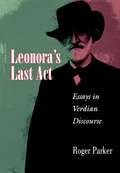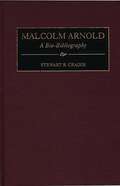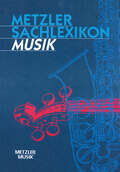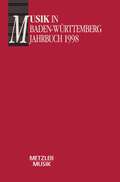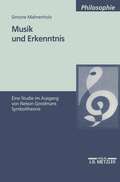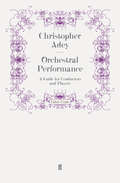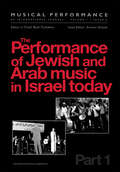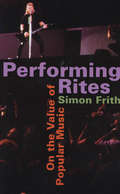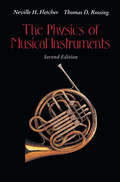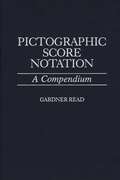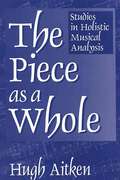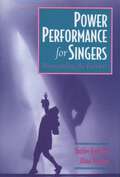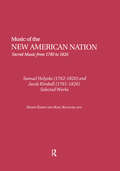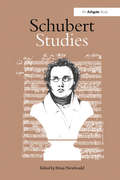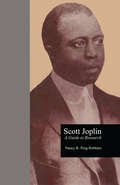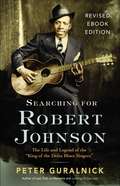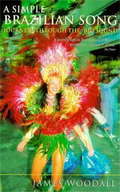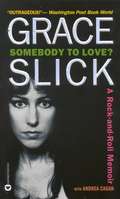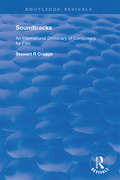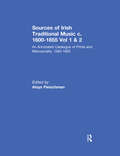- Table View
- List View
Leonora's Last Act: Essays in Verdian Discourse (Princeton Studies in Opera #31)
by Roger ParkerIn these essays, Roger Parker brings a series of valuable insights to bear on Verdian analysis and criticism, and does so in a way that responds both to an opera-goer's love of musical drama and to a scholar's concern for recent critical trends. As he writes at one point: "opera challenges us by means of its brash impurity, its loose ends and excess of meaning, its superfluity of narrative secrets." Verdi's works, many of which underwent drastic revisions over the years and which sometimes bore marks of an unusual collaboration between composer and librettist, illustrate in particular why it can sometimes be misleading to assign fixed meanings to an opera. Parker instead explores works like Rigoletto, Il trovatore, La forza del destino, and Falstaff from a variety of angles, and addresses such contentious topics as the composer's involvement with Italian politics, the possibilities of an "authentic" staging of his work, and the advantages and pitfalls of analyzing his operas according to terms that his contemporaries might have understood. Parker takes into account many of the interdisciplinary influences currently engaging musicologists, in particular narrative and feminist theory. But he also demonstrates that close attention to the documentary evidence--especially that offered by autograph scores--can stimulate equal interpretive activity. This book serves as a model of research and critical thinking about opera, while nevertheless retaining a deep respect for opera's continuing power to touch generations of listeners.
Malcolm Arnold: A Bio-Bibliography (Bio-Bibliographies in Music)
by Stewart R. CraggsMalcolm Arnold's music encompassed a variety of forms from opera and ballet through orchestral and chamber music to film scores. His most famous film score, for which he won an Oscar award in 1957, is The Bridge on the River Kwai. In 1953 he was commissioned to compose Homage to the Queen, a ballet to celebrate the coronation of Queen Elizabeth II. Arnold was knighted by the Queen in 1993 in honor of his contributions to English music. As with the other volumes in the Greenwood Bio-Bibliographies in Music series, this work includes a brief biography, discography, complete list of works and performances, and an annotated bibliography.Music scholars, musicians, and those with an interest in the music of Malcolm Arnold will appreciate the extensive information gathered in this one volume. Since Malcolm Arnold has retired from composing, this book features the most complete list of his compositions, including some of his newly discovered early works. The works are listed alphabetically within genre. The author also provides a chronological listing of the works through which trends and developments in Arnold's compositions may be traced. Sir Malcolm Arnold's input with the project assures the accuracy and completeness of this bio-bibliography.
Metzler Sachlexikon Musik
by Ralf NoltensmeierDas kompakte Nachschlagewerk zu allen Bereichen der Musik. Das griffige Lexikon gibt Auskunft über alle Sachfragen zur Musik. Es enthält über 2.500 Artikel zu Sachen und Begriffen aus allen Bereichen der Musik - Klassik, Moderne, Weltmusik, Jazz und Unterhaltungsmusik.
Musik in Baden-Württemberg, Band 5: Jahbuch 1998
1898, vor hundert Jahren, wurde an der Universität Heidelberg mit Philipp Wolfrum der erste Professor für Musikwissenschaft im Gebiet des heutigen Bundeslandes Baden-Württemberg berufen. Aus diesem Anlaß befassen sich vier Beiträge in diesem Jahrbuch mit der Geschichte der musikwissenschaftlichen Lehre in Baden und Württemberg: Thomas Schipperges mit Heidelberg, Michael Kaufmann mit Karlsruhe, Eckhard John mit der Freiburger Ära Wilibald Gurlitts sowie Gabriela Rothmund-Gaul mit dem Amt des Tübinger Universitätsmusikdirektors. Es folgen Beiträge zu regionalgeschichtlich bedeutenden Komponisten: Hans-Bruno Ernst beschäftigt sich mit Josef Anton Laucher (1737-1813); Clytus Gottwald mit Joseph Huber (1837-1886), der zur selben Zeit wie Wagner eine eigenständige musikdramatische Form entwickelte; Lee A. Rothfarb mit August Halm (1869-1929) sowie Paul Feuchte mit dem Heidelberger Richard Franck. Neben weiteren Aufsätzen enthält der Band, wie stets, die Musikbibliographie Baden-Württemberg, die Rubrik Neue und restaurierte Orgeln" sowie einen umfangreichen Rezensionsteil zu Neuerscheinungen."
Musik und Erkenntnis: Eine Studie im Ausgang von Nelson Goodmans Symboltheorie
by Simone MahrenholzDass im Umgang mit Kunst, speziell mit Musik ein Kontakt zu so etwas wie Wahrheit oder Erkenntnis zustandekommt - Intuitionen dieser Art durchziehen nicht nur die philosophische Ästhetik seit mehreren Jahrhunderten. Sie begegnen einem beim Hören oder Erschaffen von Musik auch zuweilen selbst.
Orchestral Performance: A Guide for Conductors and Players
by Christopher AdeyA comprehensive guide to the techniques of orchestral playing and the development of non-professional orchestras, Orchestral Performance covers all areas of orchestral music-making - instrumental technique and combination, ensemble, layout, repertoire and presentation. Christopher Adey - renowned specialist in the training of student orchestras - explores the responsibilities of both players and conductor, exposing many of the inadvertent results of interpretation with regard to sound and projection, and broadening the musical communication to which the less experienced orchestra can aspire.Written in a lively and authoritative style, this unique book is essential reading for performing musicians of all standards, instrumental teachers and aspiring conductors, and all who have any dealings with the performance of youth or student orchestras throughout the world, as well as anyone interested in what orchestral performance entails. 'A labour of love and wisdom.' Times Educational Supplement'A treasure house of facts, advice, and hints. I could not put it down ... clearly written from the heart and from an obvious enthusiasm for the non-professional orchestra and orchestral musician.' Classical Music'This is a thoroughly readable book, full of illustrations and containing the thoughts of someone with a wealth of experience.' Music Teacher
The Performance of Jewish and Arab Music in Israel Today: A special issue of the journal Musical Performance
by Amnon ShiloahIsrael, with its highly heterogeneous immigrant society, offers to the observer a fascinating instance of multifaceted performance practice. Within a relatively limited area, there are numerous musical traditions and styles which encompass sacred and secular, old and new, folk and sophisticated forms. The ten contributions included in these issues of Musical Performance represent a discussion of the most significant traditions that were established during the period before 1948: the search for the establishment of a new and typically Israeli art and folk music; the attitude of the protagonists of this tendency toward the old exiled traditional heritage of the Jewish people, and the struggle of the immigrants after the creation of the State of Israel to ensure the survival of their musical tradtions as well as to cope with the new physical and cultural environment. Altogether the general scope of these contributions correspond to a large extent to major events which marked the m
The Performance of Jewish and Arab Music in Israel Today: A special issue of the journal Musical Performance
by Amnon ShiloahIsrael, with its highly heterogeneous immigrant society, offers to the observer a fascinating instance of multifaceted performance practice. Within a relatively limited area, there are numerous musical traditions and styles which encompass sacred and secular, old and new, folk and sophisticated forms. The ten contributions included in these issues of Musical Performance represent a discussion of the most significant traditions that were established during the period before 1948: the search for the establishment of a new and typically Israeli art and folk music; the attitude of the protagonists of this tendency toward the old exiled traditional heritage of the Jewish people, and the struggle of the immigrants after the creation of the State of Israel to ensure the survival of their musical tradtions as well as to cope with the new physical and cultural environment. Altogether the general scope of these contributions correspond to a large extent to major events which marked the m
Performing Rites: On the Value of Popular Music
by Simon FrithAn influential writer on popular music asks what we talk about when we talk about music. Instead of dismissing emotional response and personal taste as inaccessible to academic critics, Frith takes these forms of engagement as his subject—and discloses their place at the center of the aesthetics that structure our culture and color our lives.
The Physics of Musical Instruments
by Neville H. Fletcher Thomas D. RossingWhile the history of musical instruments is nearly as old as civilisation itself, the science of acoustics is quite recent. By understanding the physical basis of how instruments are used to make music, one hopes ultimately to be able to give physical criteria to distinguish a fine instrument from a mediocre one. At that point science may be able to come to the aid of art in improving the design and performance of musical instruments. As yet, many of the subtleties in musical sounds of which instrument makers and musicians are aware remain beyond the reach of modern acoustic measurements. This book describes the results of such acoustical investigations - fascinating intellectual and practical exercises. Addressed to readers with a reasonable grasp of physics who are not put off by a little mathematics, this book discusses most of the traditional instruments currently in use in Western music. A guide for all who have an interest in music and how it is produced, as well as serving as a comprehensive reference for those undertaking research in the field.
Pictographic Score Notation: A Compendium (Non-ser.)
by Gardner ReadThis text provides the first comprehensive examination of pictographic notation. Pictographic musical notation represents the relevant instruments themselves rendered visually rather than verbally. Used most extensively in contemporary publications between the 1950s and 1980s, its popularity has waned in recent years. This expertly researched work displays the resourcefulness and inventiveness of 20th century orchestrators.Providing a detailed examination of pictographic score notation, this unique book passes over 60 years of contemporary composition and score publications. Divided into three sections, this work describes instrumental pictographs, stage diagrams, and pictographic performance directives. In addition to the thoroughly researched information and extensive technique illustrations, commentary on individual examples and frequent cross-referencing of related examples, differentiate this work from other journal articles and notation texts.
The Piece as a Whole: Studies in Holistic Musical Analysis
by Hugh AitkenDesigned to serve music students at the college level, this informal approach to music theory relates the technical aspects of music with the expressive character of the art. The approach is holistic in the sense that it focuses on the interrelationships between the piece as heard by a socially conditioned listener and the notated, performed score: it aims to bridge the gap between the technical and expressive aspects of music. The composers addressed are: Bach, Mozart, Beethoven, Chopin, Schumann, Brahms, Wagner, Debussy, and Schoenberg. There are separate chapters on the problems of meaning in music and on the interdependence of aesthetic and ethical value-judgments. This novel and exciting approach to music theory will be a welcome addition to the musical analysis literature.
Power Performance for Singers: Transcending the Barriers
by Shirlee Emmons Alma ThomasTo perform well in today's highly competitive world where technical skills have been advanced to an unprecedented degree, a singer must be able to handle incredible pressure within the performing arena; his or her ability to deal with this stress will often determine whether he or she will succeed. Why, then, do singers with less technical skill sometimes out-perform stars? Why do some stars suddenly stop performing? What is that mysterious factor that makes an electric performance? Consistent, competent performances do not depend solely upon superior vocal skills, nor are they a matter of luck. On the contrary, the best performances result from a combination of mental attitude, concrete performing skills, and excellent technical skills in that order. Yet most singers have never had the opportunity to acquire the essential skills that make for a successful career. Written as a self-help manual for singers at all levels of expertise, Power Performance for Singers is designed to teach performing artists, and especially singers, how to experience elite performance at their level. The skills outlined in this book will help singers use what they have, to enjoy their voices during performance, and to perform consistently to the best of their present ability.
Samuel Holyoke: Selected Works (Music of the New American Nation: Sacred Music from 1780 to 1820 #12)
by Harry EskewThis series presents the music of early American composers of sacred music・psalmody, as it was called・in collected critical editions. Each volume has been prepared by a scholar who has studied the musical history of the period and the stylistic qualities of the composer. The purpose of the series is to present the music of important early American composers in accurate editions for both performance and study. This volume presents representative compositions by two American psalmodists, Samuel Holyoke and Jacob Kimball, who were actively engaged in the reform of American psalmody during the 1790s and early 1800s. American compositions were often criticized for two features: their failure to conform to the harmonic norms of European art music and their often vigorous, animated musical style, which was sometimes considered lacking in a reverent spirit appropriate for use in public worship
Samuel Holyoke: Selected Works (Music of the New American Nation: Sacred Music from 1780 to 1820)
by Harry Eskew Karl KroegerThis series presents the music of early American composers of sacred music・psalmody, as it was called・in collected critical editions. Each volume has been prepared by a scholar who has studied the musical history of the period and the stylistic qualities of the composer. The purpose of the series is to present the music of important early American composers in accurate editions for both performance and study. This volume presents representative compositions by two American psalmodists, Samuel Holyoke and Jacob Kimball, who were actively engaged in the reform of American psalmody during the 1790s and early 1800s. American compositions were often criticized for two features: their failure to conform to the harmonic norms of European art music and their often vigorous, animated musical style, which was sometimes considered lacking in a reverent spirit appropriate for use in public worship
Schubert Studies: A New Perspective (Symphonic Studies)
by Brian NewbouldSchubert Studies comprises eleven essays by renowned Schubert scholars and performers. The volume sheds light on certain aspects of Schubert‘s music and biography which have hitherto remained relatively neglected, or which warrant further investigation. Musical topics include analyses of tempo conventions, transitional procedures and rhythmic organization. There are reassessments of several works, using autograph research, performing experience and other approaches; while assumptions as to the extent of Schubert‘s influence on later Czech composers are also brought into question. Concerns with aspects of Schubert‘s biography, in particular the social and musical circles in which he moved, come under examination in several essays. The final two chapters deal specifically with the composer‘s relationships with women, and the psychological and physiological illnesses from which he suffered. Each of the essays here charts new and existing evidence to provide fresh perspectives on these aspects of Schubert‘s life and music, making this volume an indispensable tool for scholars concerned with his work.
Schubert Studies
by Brian NewbouldSchubert Studies comprises eleven essays by renowned Schubert scholars and performers. The volume sheds light on certain aspects of Schubert‘s music and biography which have hitherto remained relatively neglected, or which warrant further investigation. Musical topics include analyses of tempo conventions, transitional procedures and rhythmic organization. There are reassessments of several works, using autograph research, performing experience and other approaches; while assumptions as to the extent of Schubert‘s influence on later Czech composers are also brought into question. Concerns with aspects of Schubert‘s biography, in particular the social and musical circles in which he moved, come under examination in several essays. The final two chapters deal specifically with the composer‘s relationships with women, and the psychological and physiological illnesses from which he suffered. Each of the essays here charts new and existing evidence to provide fresh perspectives on these aspects of Schubert‘s life and music, making this volume an indispensable tool for scholars concerned with his work.
Scott Joplin: A Guide to Research (Routledge Music Bibliographies)
by Guy Marco Nancy R. Ping RobbinsFirst Published in 1998. Routledge is an imprint of Taylor & Francis, an informa company.
Scott Joplin: A Guide to Research (Routledge Music Bibliographies #Vol. 7)
by Nancy R. Ping-RobbinsFirst Published in 1998. Routledge is an imprint of Taylor & Francis, an informa company.
Searching for Robert Johnson: The Life and Legend of the "King of the Delta Blues Singers"
by Peter GuralnickThis highly acclaimed biography from the author of Last Train to Memphis illuminates the extraordinary life of the most influential blues singer of all time, the legendary guitarist and songwriter whose music inspired generations of musicians, from Muddy Waters to the Rolling Stones and beyond. The myth of Robert Johnson&’s short life and mysterious death has often overshadowed his music. According to legend, Johnson sold his soul to the Devil in exchange for an unmatched musical ability that would set him apart from his peers in the Mississippi Delta. When he died in 1938 at the age of just twenty-seven, supposedly poisoned by the jealous husband of a woman he&’d been flirting with at a dance, he had recorded only twenty-nine songs, but those songs would endure as musical touchstones for generations of blues performers. This brilliant book explores both the myth and the music of Robert Johnson. As in his masterful biographies of Elvis Presley, Sam Phillips, and Sam Cooke, Peter Guralnick here gives readers an insightful, thought-provoking, and deeply felt picture of Johnson and of the rich Delta blues tradition which his music exemplified. &“I finished the book feeling that, if only for a brief moment, Robert Johnson had stepped out of the mists.&” —Patricia Romanowski, New York Times Book Review
A Simple Brazilian Song: Journeys Through The Rio Sound
by James WoodallIn 1992, James Woodall was asked to write an article about a Brazilian musician he'd never heard of, called Chico Buarque. He discovered that Buarque was a national hero in his native country and that interviewing him was a bit like a Latin American interviewing Paul McCartney. Woodall fell under Buarque's spell and began an affair with Brazilian pop music which has lasted to this day. His new passion took him to Brazil and in particular to Rio de Janeiro, world capital of Carnival and samba. Over several visits, he met with Chico Buarque, discovered the city's immodest beach culture and took part in Carnival. He met Chico Buarque's great contemporary, Caetano Veloso and other stars. Picking up Portuguese on the hop, he learnt a great deal about Chico Buarque's life and about the strange and dangerous city where he lives. This book is as much a hymn to Rio de Janeiro as it is to the music that beats at its heart.
Somebody to Love?: A Rock-and-Roll Memoir
by Grace Slick Andrea CaganA candid autobiography of the great rock diva of Jefferson Airplane and Jefferson Starship, revealing her wild life at the forefront of the Sixties and Seventies counterculture.She has been called rock and roll's original female outlaw, as famous for her bad behavior as for her haunting singing voice. In her 25-year career as a musician, Grace Slick charted dozens of hits and sold millions of albums. From "White Rabbit" and "Somebody to Love" to "Sarah" and "Miracles", the songs she performed became the anthems of a generation.Whether describing her antics at the White House with Abbie Hoffman or the unforgettable experience that was Woodstock, Slick's recollections have the same rich imagery found in her lyrics. In this provocative narrative, readers will discover the many sides of Grace Slick: as artistic pioneer; she records songs with Jerry Garcia and David Crosby; as practitioner of freedom and rebellion; she sleeps with Jim Morrison and gets arrested for DUI on three separate occasions (without actually being in a car); and as a loving mother to actress China Kantner, she tries to balance casual friendship with parental wisdom.Slick offers a revealing self-portrait of the complex woman behind the rock-outlaw image, and delivers a behind-the-scenes, no-holds-barred view of the people and spirit that defined a quarter-century of American pop culture. Wildly funny, candid, and evocative, Somebody to Love?tells what it was really like during, and after, the Summer of Love-and how one remarkable woman survived it all to remain today as vibrant and rebellious as ever.
Soundtracks: International Dictionary of Composers of Music for Film (Routledge Revivals)
by Stewart R. CraggsFirst published in 1998, music scored for film has only relatively recently received the critical attention which it merits. Many composers in the twentieth century have written works for films or documentaries, a number feeling that this aspect of their output has been undervalued. This dictionary complements other studies which have appeared in recent years which look at the technical and theoretical issues concerned with film music composition. Arranged alphabetically by composer, the volume comprises over 500 entries covering all nationalities. Each entry includes very brief biographical information on the composer, followed by a list of the films (with dates) for which he or she has composed. Details of recordings are also given. The dictionary’s international coverage ensures that it will become a standard reference work for all those interested in the history of twentieth-century music and the development of film.
Soundtracks: International Dictionary of Composers of Music for Film (Routledge Revivals)
by Stewart R. CraggsFirst published in 1998, music scored for film has only relatively recently received the critical attention which it merits. Many composers in the twentieth century have written works for films or documentaries, a number feeling that this aspect of their output has been undervalued. This dictionary complements other studies which have appeared in recent years which look at the technical and theoretical issues concerned with film music composition. Arranged alphabetically by composer, the volume comprises over 500 entries covering all nationalities. Each entry includes very brief biographical information on the composer, followed by a list of the films (with dates) for which he or she has composed. Details of recordings are also given. The dictionary’s international coverage ensures that it will become a standard reference work for all those interested in the history of twentieth-century music and the development of film.
Sources of Irish Traditional Music c. 1600-1855: An Annotated Catalogue of Prints and Manuscripts, 1583-1855
by Aloys Fleischmann Mícheál ÓSúilleabháin Paul McGettrickFirst Published in 1998. Irish traditional music is one of the richest treasuries of folk music in the world. Being an oral tradition, much of it has already been lost, and what has been recorded is only partially available in isolated collections. Until now, no composite picture has yet been presented, showing its remarkable range and diversity over four centuries. This volume covers Irish materials in general collections up to 1800 and in Irish collections up to and including Petrie's Ancient Music of Ireland (1855).The purposes of the project are to identify Irish dance tunes and songs; to present the scholar with a mass of material showing the evolution of the Irish vocal and instrumental folk style, period by period, from the earliest recorded tune up to the middle of the last century; to put into circulation many of the splendid airs which were lost but have now been located. Some 6,000 songs and dance tunes are presented, also including Scottish and English tunes. Included are Scottish tunes that were used by 18th-century Irish poets for their verses, and both English and Scottish tunes that are still current among Irish traditional musicians. Tunes of present-day currency which do not seem to be included may still be located by comparing their first 12 notes in the thematic index at the end of the volume.To make the vast array of material readily available, an index allows readers to locate a tune by its melodic incipit, by any of its titles, or by the first line of its text. Unfortunately, the vast majority of Irish songs noted up to the end of the last century lack texts, since the collectors were ignorant of the Irish language. But almost every other facet is covered-provenance, tonality structure, and variants.
